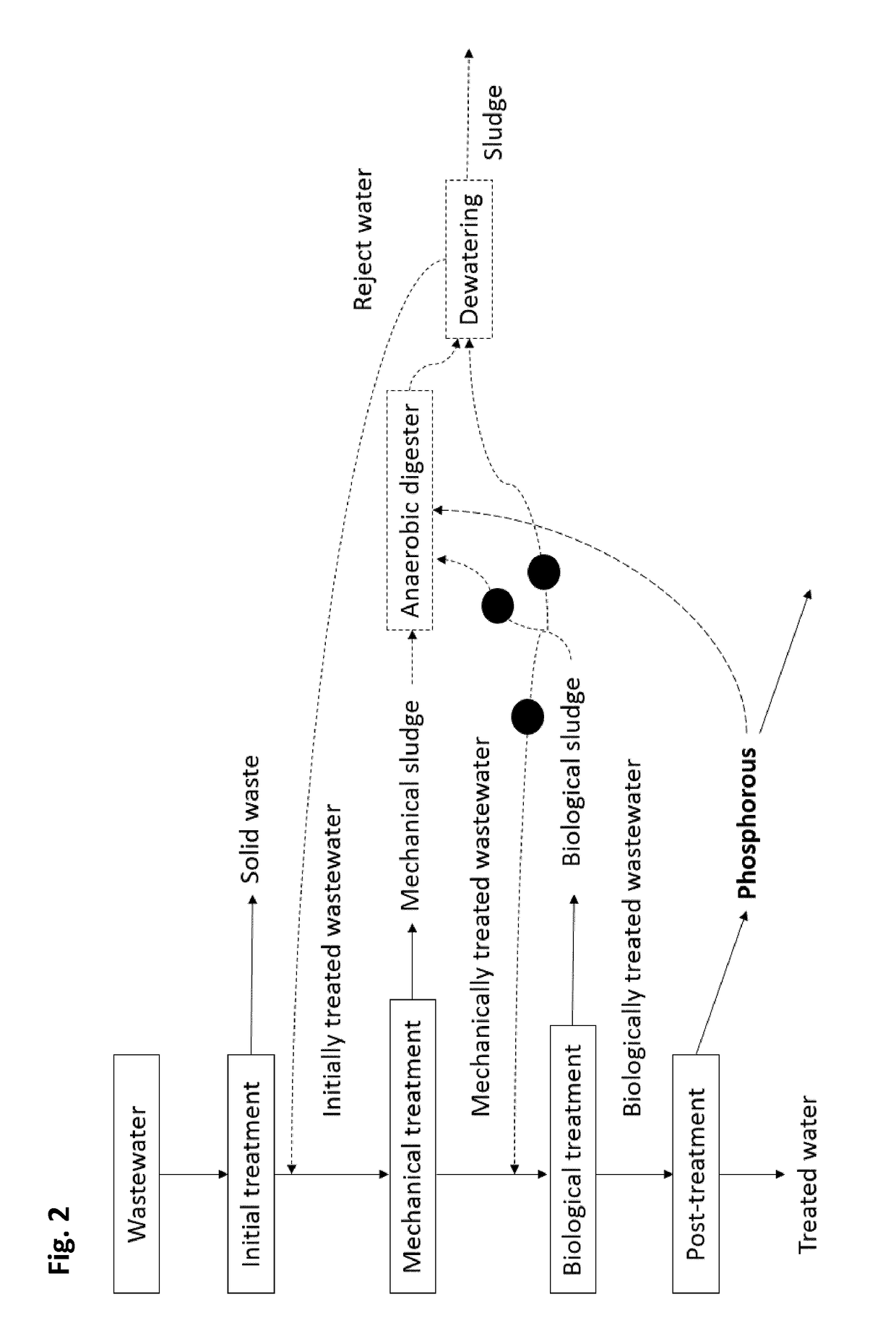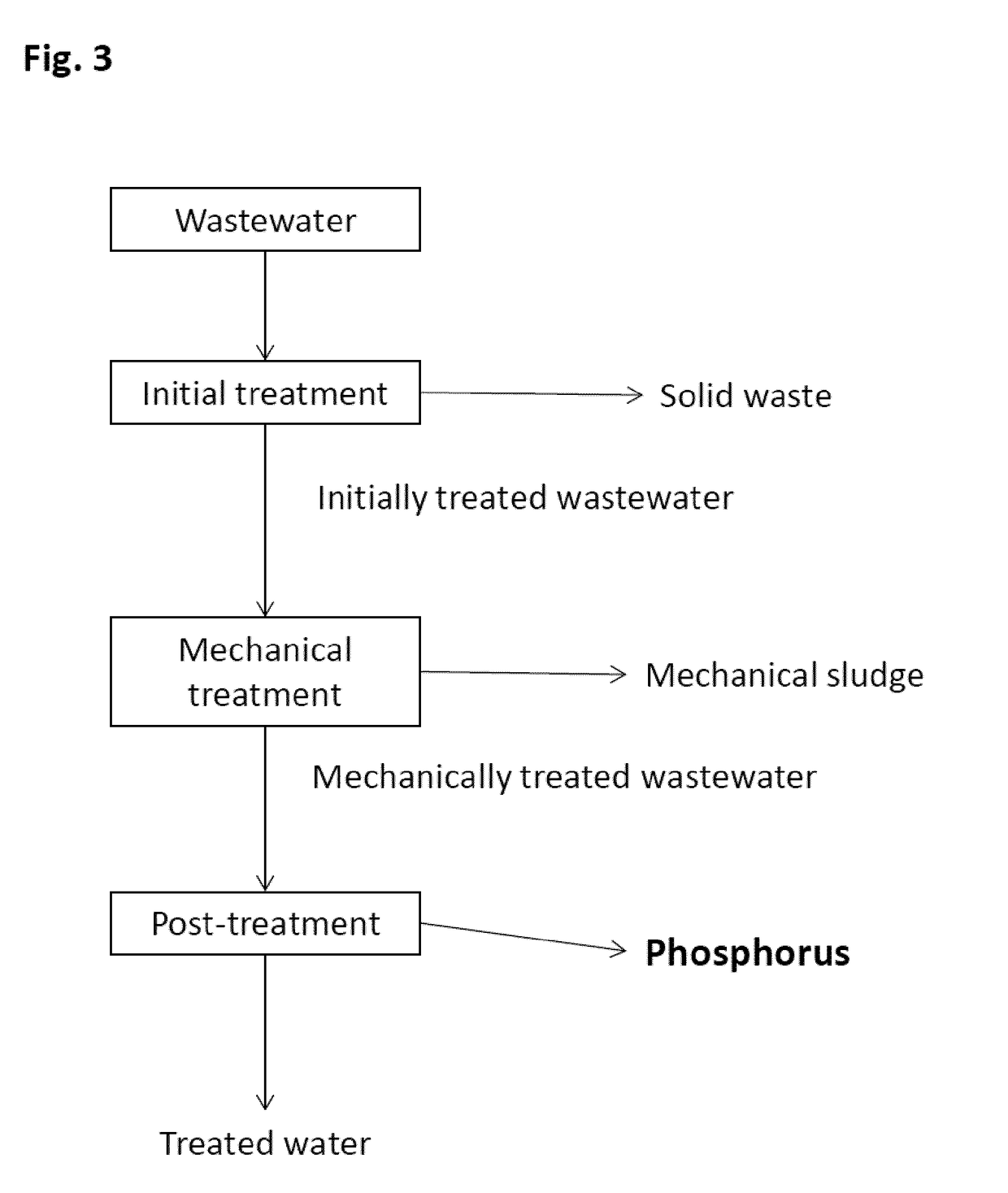Recovery of phosphorus compounds from wastewater
- Summary
- Abstract
- Description
- Claims
- Application Information
AI Technical Summary
Benefits of technology
Problems solved by technology
Method used
Image
Examples
example 1
n of the Mechanical Sludge Using Polyacrylamide (PAM), Polyamine (PA) and Poly-DADMAC Flocculants (p-D), and Conventional Inorganic Coagulants Ferric Chloride (PIX) and Polyaluminium Chloride (PAX)
[0058]a) Incoming wastewater to the wastewater treatment plant was taken from the process. Dry solids content was 0.05%. Flocculant solution were prepared dissolving the dry polymers (100% active agent) to 0.1% active agent solutions and polymer solutions to 5% active agent concentrations. 900 g of that incoming wastewater was taken into a beaker. A motor mixer was placed in the beaker and turned on at the speed of 200 rpm. The mixing at this speed was continued for 30 seconds, during which the flocculant solution was added into the well mixing solution using a pipette. Then the stirring was slowed down to 40 rpm and continued stirring at this speed for 5 min. After this the stirring was stopped and formed flocs were let to settle for 10 min, after which the sampling was done in the depth ...
example 2
s Recovery in the Post-Treatment
[0061]The phosphorus recovery in the post-treatment was simulated in the laboratory scale using wastewater from a wastewater treatment plant having a biological treatment process. As the wastewater treatment practises today require the removal of phosphorus, the total phosphorus in the wastewater was reduced to meet these requirements at the plant. Thus phosphorus level was raised to the desired level using Na3PO4 in order to simulate the phosphorus recovery according to the invention.
[0062]a) Precipitation Using Ferric Coagulant[0063]20 liters of wastewater with total phosphorus of 0.33 mg / l was taken from the process. 529.0 mg of Na3PO4 was added to raise the phosphorus level to 5 mgP / l. 1000 ml of so prepared phosphorus rich wastewater was taken into a beaker. A motor mixer was turned on at the speed of 400 rpm. Immediately after starting the mixing, the desired dosage of Fe-coagulant PIX-111 (Fe 13.7%, density 1.44 g / ml) for precipitating phosphor...
example 3
of the Separation of the Mechanical Sludge on the Biological Treatment Step
[0080]Incoming wastewater to mechanical separation was taken from the wastewater treatment plant, and treated in three different ways:
[0081]Batch 1 was done without any chemical addition into 400 litres of incoming wastewater (referred as No chemicals).
[0082]Batch 2 was done by adding 36 ml ferric chloride (PIX-111) into 200 litres of incoming wastewater (referred to as PIX-111).
[0083]Batch 3 was done by adding 1500 ml of polymer solution (C492, a PAM) (0.1% w / w) into the total volume of 300 liters of incoming wastewater (200 litres and 100 litres batches) (referred as C492).
[0084]The containers were first filled with the incoming wastewater. A vigorous mixing was turned on. The used mixer was a drilling machine with a concrete mixer blade that is normally used at construction sites. The chemicals disclosed were added fast into Batches 2 and 3. Mixing was turned off 5-10 seconds after the chemical additions w...
PUM
 Login to View More
Login to View More Abstract
Description
Claims
Application Information
 Login to View More
Login to View More - R&D
- Intellectual Property
- Life Sciences
- Materials
- Tech Scout
- Unparalleled Data Quality
- Higher Quality Content
- 60% Fewer Hallucinations
Browse by: Latest US Patents, China's latest patents, Technical Efficacy Thesaurus, Application Domain, Technology Topic, Popular Technical Reports.
© 2025 PatSnap. All rights reserved.Legal|Privacy policy|Modern Slavery Act Transparency Statement|Sitemap|About US| Contact US: help@patsnap.com



